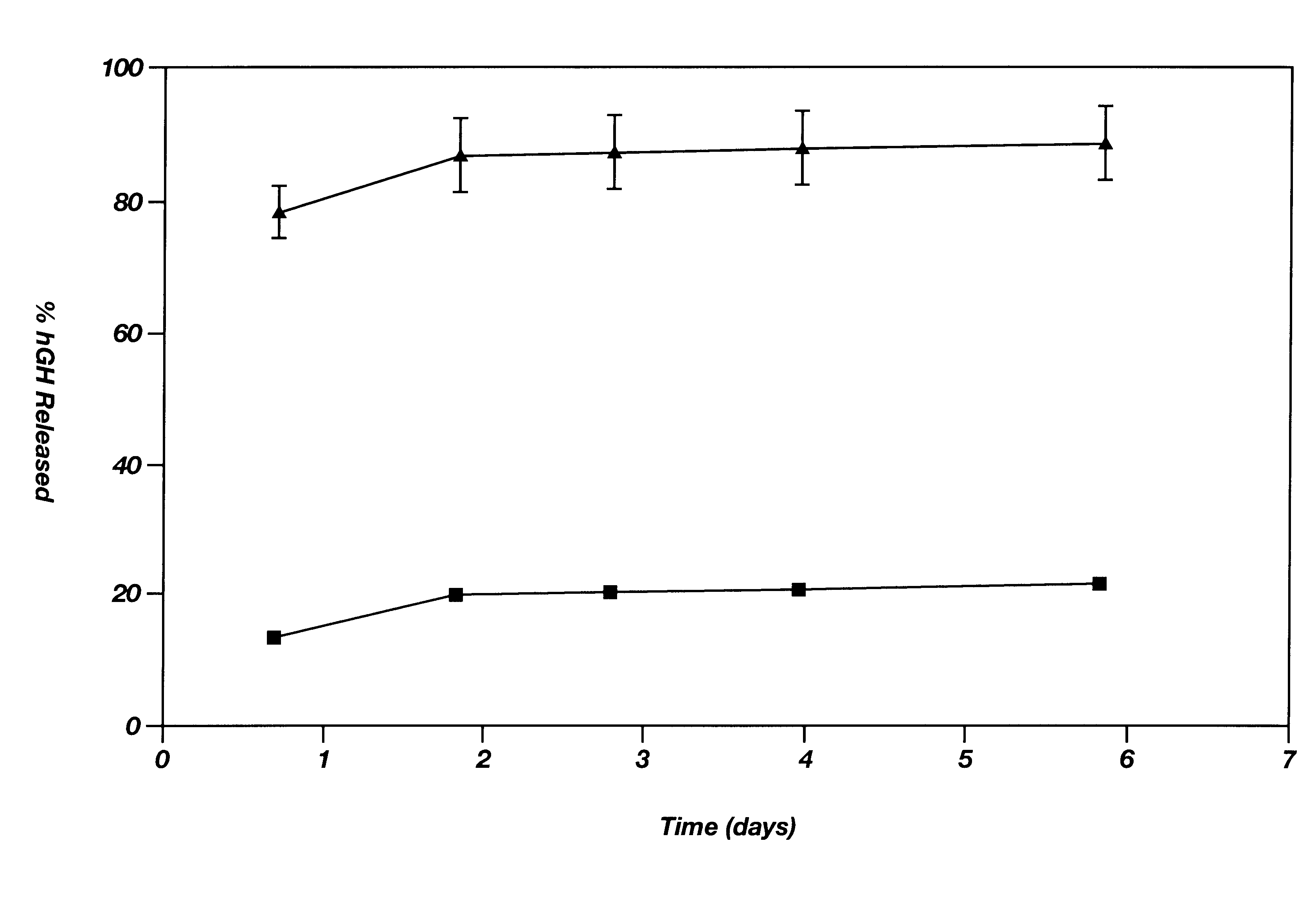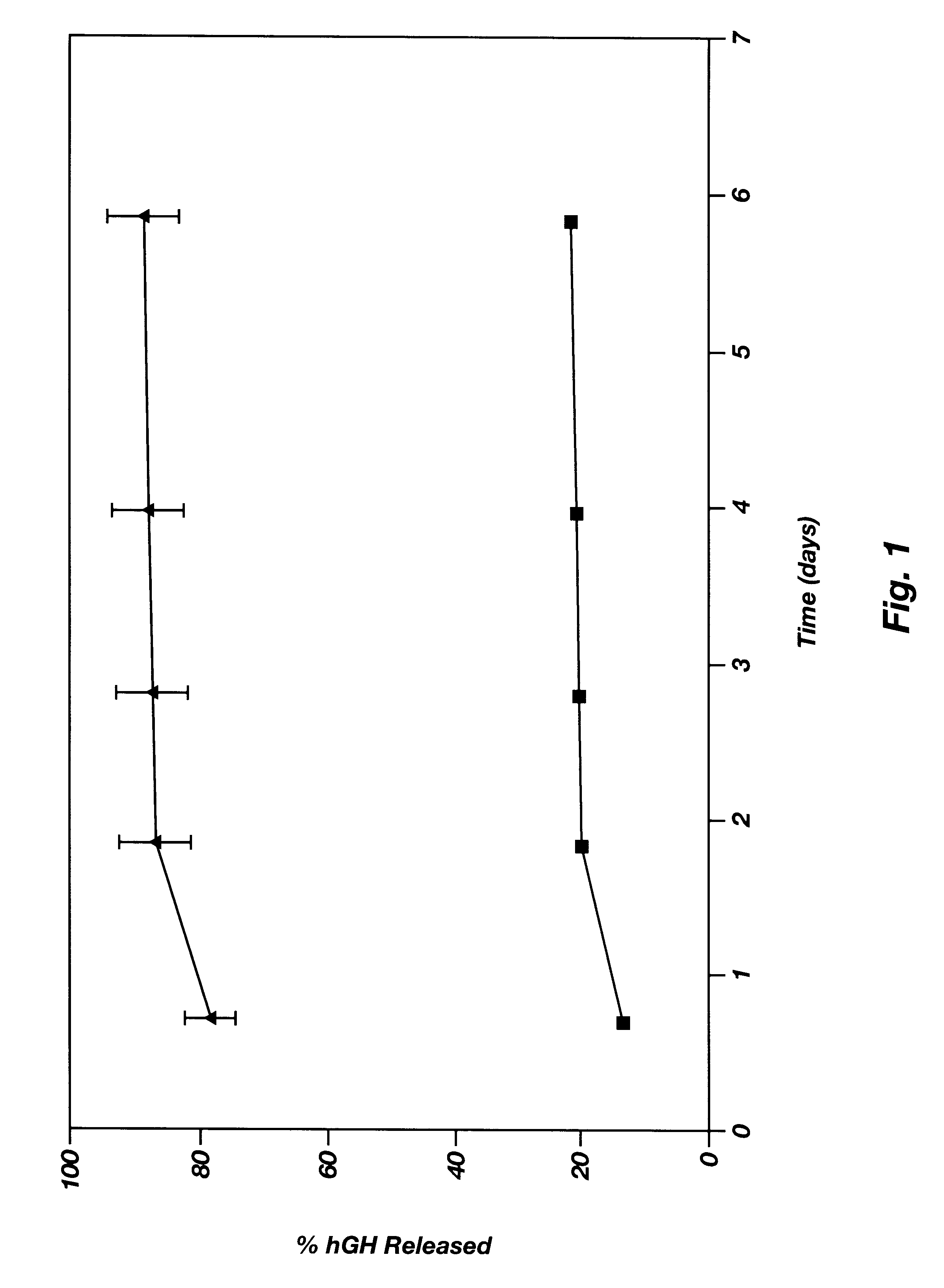Agent delivering system comprised of microparticle and biodegradable gel with an improved releasing profile and methods of use thereof
- Summary
- Abstract
- Description
- Claims
- Application Information
AI Technical Summary
Benefits of technology
Problems solved by technology
Method used
Image
Examples
example 2
This example illustrates the agent release profile (in vivo) of a microparticle-reverse thermal gelation(RTG) agent delivery system.
Zinc-hGH (12%) poly(D,L-lactide-co-glycolide) microspheres (160 mg) are suspended in 1.5 mL of a RTG(20% in 10 mM HEPES, pH 6.5). Three immuno-suppressed rats each is given 0.3-mL subcutaneous injections of the formulation in the dorsal lateral area. Rats in the control group are given the same dose of the microspheres but the vehicle is normal saline (with 3% low molecular weight carboxymethylcellulose as the suspending agent and 0.5% TWEEN 20). It is noticed that the RTG formulation can be injected smoothly using a 24-gauge needle (due to the excellent wetting and suspending ability of the RTG) while clogging of the needle often occurs in the control. Blood samples are collected periodically and the hGH concentrations in plasma are determined by radioimmunoassay (RIA). The plasma hGH profile of the rats given the RTG formulation shows a much smaller i...
example 3
This example illustrates the agent release profile (in vivo) of a microparticle-Pluronic.RTM. F127 agent delivery system. Pluronic.RTM. is a registered trademark of BASF for block copolymers of ethylene oxide and propylene oxide. Block copolymers of ethylene oxide and propylene oxide are not biodegradable.
Similar formulation described in Example 2 is used in this example except that the RTG is substituted with Pluronic.RTM. F127 (20% in 10 mM HEPES, pH 6.5). Rats in the controlled group are given same dose of the microspheres and the vehicle is normal saline (with 3% low molecular weight carboxymethylcellulose as the suspending agent and 0.5% TWEEN 20). Injections are smooth using 23-gauge needles. No plugging or clogging is experienced. Blood samples are collected periodically and hGH concentrations in plasma are determined by radioimmunoassay (RIA). Plasma hGH profile of the rats given microparticle-Pluronic.RTM. formulation shows a much smaller initial burst of hGH than those obt...
example 4
This example illustrates the agent release profile (in vivo) of a microparticle-Tetronic.RTM.1307 agent delivery system. Teronic.RTM. is a registered trademark of BASF for amine based block copolymers.
Similar formulation described in Example 3 is used in this example except that the Pluronic.RTM. is substituted with Tetronic.RTM. 1307 (30% in 10 mM HEPES, pH 6.5) Rats in the controlled group are given same dose of the microspheres and the vehicle is normal saline (with 3% low molecular weight carboxymethylcellulose as the suspending agent and 0.5% TWEEN 20). Injections are smooth using 23-gauge needles. No plugging or clogging is experienced. Blood samples are collected periodically and hGH concentrations in plasma are determined by radioimmunoassay (RIA). Plasma hGH profile of the rats given microparticle-Tetronic.RTM. formulation shows a much smaller initial burst of hGH than those obtained from the control group.
PUM
| Property | Measurement | Unit |
|---|---|---|
| Percent by mass | aaaaa | aaaaa |
| Percent by mass | aaaaa | aaaaa |
| Percent by mass | aaaaa | aaaaa |
Abstract
Description
Claims
Application Information
 Login to View More
Login to View More - R&D
- Intellectual Property
- Life Sciences
- Materials
- Tech Scout
- Unparalleled Data Quality
- Higher Quality Content
- 60% Fewer Hallucinations
Browse by: Latest US Patents, China's latest patents, Technical Efficacy Thesaurus, Application Domain, Technology Topic, Popular Technical Reports.
© 2025 PatSnap. All rights reserved.Legal|Privacy policy|Modern Slavery Act Transparency Statement|Sitemap|About US| Contact US: help@patsnap.com


